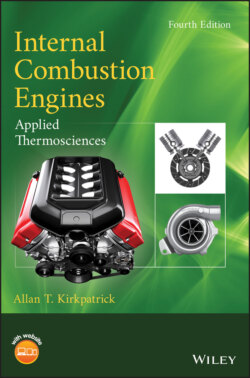Читать книгу Internal Combustion Engines - Allan T. Kirkpatrick - Страница 30
1.5 Engine Configurations
ОглавлениеInternal combustion engines can be built in many different configurations. For a given engine, using a four‐ or two‐stroke Otto or Diesel cycle, the configurations are characterized by the piston‐cylinder geometry, the inlet and exhaust valve geometry, the use of super or turbochargers, the type of fuel delivery system, and the type of cooling system. The reciprocating piston‐cylinder combination remains the dominant configuration of the internal combustion engine.
Since the invention of the internal combustion engine, many different piston‐cylinder geometries have been designed, as shown in Figure 1.13. The choice of a given arrangement depends on a number of factors and constraints, such as engine balancing and available volume. The in‐line engine is the most prevalent because it is the simplest to manufacture and maintain. The V engine is formed from two in‐line banks of cylinders set at an angle to each other, forming the letter V. A horizontally opposed or flat engine is a V engine with 180 offset piston banks. The W engine is formed from three in‐line banks of cylinders set at an angle to each other, forming the letter W. A radial engine has all of the cylinders in one plane with equal spacing between cylinder axes. Radial engines are used in air‐cooled aircraft applications since each cylinder can be cooled equally. Since the cylinders are in a plane, a master connecting rod is used for one cylinder, and articulated rods are attached to the master rod. Alternatives to the reciprocating piston‐cylinder arrangement have also been developed, such as the rotary Wankel engine, in which a triangular shaped rotor rotates eccentrically in a housing to achieve compression, ignition, and expansion of a fuel–air mixture.
Figure 1.13 Various piston‐cylinder geometries. (Adapted from Obert 1950.)
